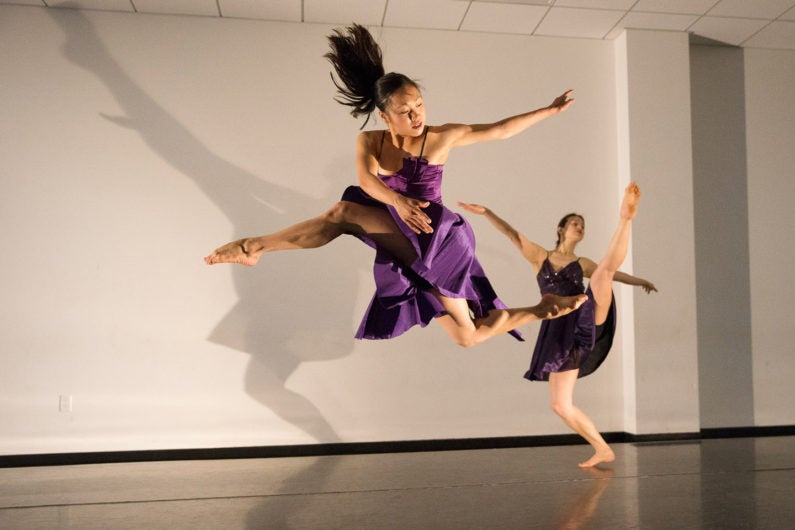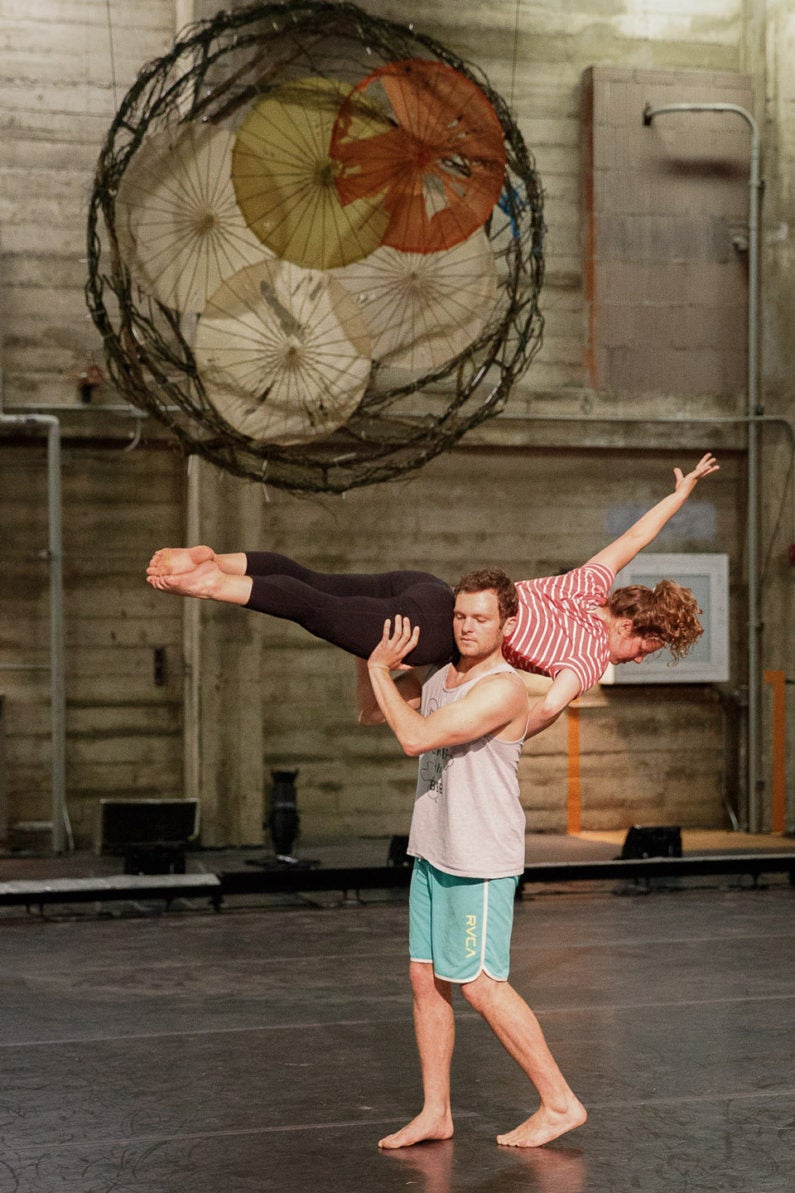New Stanford dance performances highlight different views toward ‘space’
Four Stanford dance faculty members created four new dance works, showing how dance interacts and engages with space in different ways. The performances are slated for May 26-27 in Memorial Auditorium.

Stanford freshman Cora Cliburn, foreground, and doctoral candidate Glory Liu will dance on the Memorial Auditorium stage this Thursday and Friday in dances created by faculty members. (Image credit: Frank Chen)
With a nod toward the artistry of “space,” the dance performance Spatial Shift will take place May 26-27 in Memorial Auditorium on the Stanford campus.
The final event in the Department of Theater & Performance Studies’ 2015-16 performance season, Spatial Shift is a series of new dance works by Stanford faculty members Diane Frank, Aleta Hayes, Alex Ketley and Robert Moses. It is subtitled Four Dances in Four Stages.
Spatial Shift will be performed at 8 p.m. on Thursday and Friday nights. Tickets range from $5 to $15, and are on sale now.
The four Stanford faculty members behind the production have many decades of experience, collectively, teaching and choreographing dance. They have also won several NEA grants and fellowships, founded dance and movement companies in the Bay Area and Stanford community, and choreographed other performances, including ones at the American College Dance Festival and at the Kennedy Center in Washington, D.C.
Common denominator
Their new work, Spatial Shift, focuses on space as an inevitable and irreducible common denominator for dance as an art form – the baseline content for any body in action. The choreographers used their own personal conceptions of space as the inspiration for each individual work.
The idea of how dance and theater engage with space is especially significant as TAPS will open the newly renovated Roble Gym Theater this fall. In the final stages of its $28 million upgrade, Roble will include improved dance studios and rehearsal spaces.
In acknowledgment of the excitement behind the Roble renovations, the Department of Theater & Performance Studies sought to mark this shift with a “last hurrah” production on Stanford’s oldest performing arts space – Memorial Auditorium’s main stage.
Stanford freshman dancer Cora Cliburn, who was recently featured as Dance Magazine’s “Top 25 to Watch” for 2016, will dance on the Memorial Auditorium stage in three pieces of Spatial Shift.

Stanford alumnus Ben Cohn and research assistant Judith Syrkin-Nikolau rehearse Aleta Hayes’ “Spring Charrette” for this week’s performances of Spatial Shift. (Image credit: Frank Chen)
Cliburn said, “When I first visited campus, the dance department and the old Roble were two of the things that drew me to coming here. I think it is hugely important for dance to have a designated home, as it allows movement to be a part of the campus ethos – providing space for the cross-fertilization and conversations that make Stanford unique.”
She added, “Beyond the physical challenge of the choreography, each of the rehearsal processes has asked each of us to share our full selves. I am looking forward to perform on the Memorial Auditorium stage, as the pieces we’ve developed are complex and energetic and will no doubt fill the space.”
She noted that though the pieces are finished, structurally, they will be different each night.
Thinking about dance
Diane Frank, dance lecturer and choreographer of the piece “Branch, Tendril, Vine” in Spatial Shift, describes dance as fundamentally the experience of the body in action over time and through space.
“The truly articulate dancer is never dancing alone. He or she partners a palpable and enlivened space, and these spatial acuities are available tools used by choreographers to create movement and meaning,” Frank said.
Aleta Hayes, who founded and choreographs the Chocolate Heads Movement Band, said of her piece “Spring Charrette” that performing in Memorial Auditorium felt like a natural conclusion to the year.
“Space and architecture have been the primary focus of the Chocolate Heads’ movement research and exploration this year,” Hayes said. “Beginning in the fall, we have been creating and performing in architecturally significant buildings on campus, including the Department of Art & Art History McMurtry Building and Windhover, the contemplative center.”
Alex Ketley, who choreographs “Poem (Fragment Expansion)” in Spatial Shift, realized he was able to revisit and further develop a fragment of an idea he had had earlier.
Ketley said, “In 2015, I premiered and toured a work called Poem, during which there was a short three-minute segment where the dancers interacted with architecture. That brief moment has become the catalyst for me wanting to explore that way of work in more detail here at Stanford.”
The Stanford stage also holds a special place for Robert Moses, who has been on the dance faculty since 1995 and will leave Stanford at the end of the year to focus on his work with his company, Robert Moses’ Kin. He said he looks forward to closing his Stanford career with a piece on Stanford’s iconic Memorial Auditorium stage, a space he has choreographed for only a handful of times.
Stage is central
Though all four dances share the stage – performing back-to-back over the course of an hour – and space as the unifying prompt, the pieces are diverse in their intent, rehearsal process, vocabulary, formal decisions and supportive theatrical elements, according to Frank.
He said, “The kind of space we attend to as choreographers is the stage space. The stage is the locus of layered and accrued theatrical meaning, and when we create dances for it, we can refer to, support or up-end those expectations.”
Spatial Shift features set design by Erik Flatmo and costume design by Connie Strayer, both of whom are lecturers in Theater & Performance Studies. The lighting design was done by Stanford sophomore Stephen Hitchcock. Other collaborating artists include CCRMA-affiliated composer Dohi Moon as well as musician/composer and Chocolate Heads music director Patrick Lotilla, drummer Daniel Guaqueta, and Stanford alumnus singer Aaron Grayson.
